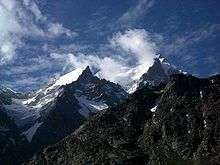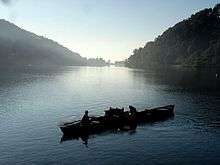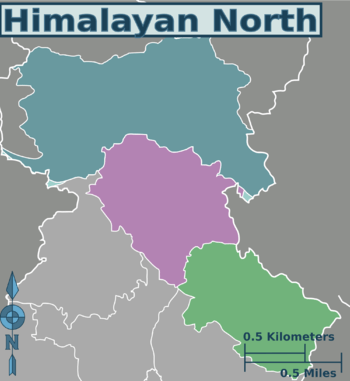Himalayan North
The Himalayan North region comprises the three northernmost Himalayan mountain states of India: Himachal Pradesh, Jammu and Kashmir, and Uttarakhand. Eastern parts of Himalayan India are in the northern sections of Eastern India and North-Eastern India, which have their own regional articles.
Cities
Here are nine of the most notable cities.
- 🌍 Dehradun — the capital of Uttarakhand
- 🌍 Dharamsala — a city popular amongst the backpacker community and where the Dalai Lama resides
- 🌍 Haridwar — a holy city for Hindus, where the Ganges river emerges from the hills to the plains
- 🌍 Jammu — the winter capital of Jammu and Kashmir
- 🌍 Leh — a bustling tourist town, large numbers of Kashmiri traders
- 🌍 Manali— a quiet picturesque town set in mountainous region by day, hosts many a rave at night
- 🌍 Shimla — the summer capital of former British India, modern India with English architecture
- 🌍 Srinagar — famous for Dal Lake and in a valley surrounded by the picturesque Himalayas
Other destinations

- 🌍 Great Himalayan National Park, Himachal Pradesh — located in the Kullu region is home to many species of wildlife. Virtually pristine forests and alpine meadows, this fragile region makes this park a wonderful destination. The national park has also been designated by UNESCO as a World Heritage Site.
- 🌍 Hemis National Park (Hemis High Altitude Park), Jammu and Kashmir — home to several endangered mammals including the snow leopard. The Tibetan wolf and golden eagle can also be found in the park. The Rumbak Valley offers opportunities for bird-watching. Snow trekking is popular here.
- 🌍 Kishtwar National Park, Jammu and Kashmir — located in the Kishtwar district, this park has rugged and steep terrain, with narrow valleys leading to glaciers. This park provides habitat for the Himalayan Snowcock and the brown bear.
- 🌍 Nanda Devi National Park Uttarakhand — surrounded by high ridges and the Rishi Glacier, this park is home for some large mammals (ie. Himilayan musk deer), carnivores (ie. Snow leopard) and birds in a land with diverse vegetation
- 🌍 Valley of Flowers National Park, Uttarakhand — a park valley of wild flowers designated a UNESCO World Heritage Site
Understand
After the heat and chaos in the big cities of the Plains, the Indian Himalayas make a relaxing change. Some foreign travelers make visiting this region their sole purpose for coming to India, and it is a popular destination for Indians as well. The Himalayan North, being the abode of the gods and the origin of Hinduism's holy rivers, is one of the most ancient travel destinations in the country. Pilgrims have been visiting this place for centuries.
The British, conquering India before air conditioning, found themselves defeated by the Indian summer. As a result, they had to take refuge in hill stations to escape the heat. This region, because of its proximity to Delhi, had the largest concentration of hill stations. The largest among these, Shimla, was the summer capital of British India. Shimla and other cities like Mussoorie and Dalhousie still retain their charming colonial atmosphere.
The valley of Kashmir used to be the honeymoon destination of choice for those who could afford it, but terrorism has made it too unsafe.
Talk

Hindi/Urdu is understood throughout the region either as a primary or secondary language. English is widely understood, especially in the more touristed parts.
Get in
By bus
The Himalayan North is well connected to the Plains by bus.
By train
Haridwar is the highest place that is accessible by train.
Get around

By bus
This is the main way to get around the Himalayan north, the only choice in many places. The winding roads and steep slopes make for some nerve wracking moments; but the views more than make up for it.
By train
Being a mountainous region there are very few rail lines. However, there is a "toy train" service that connects Kalka and Shimla. In its day, this single gauge line was a remarkable engineering feat, but now it makes for a slow and beautiful tourist route.
See
This is an extremely picturesque area of the country, with much natural beauty. As a region that borders on Tibet, it also has Tibetan-style Buddhist temples, especially in Dharamsala, where the Dalai Lama and many of his followers set up a kind of "free Tibet" in exile, but also in the region of Ladakh, Jammu and Kashmir, which has a home-grown but Tibetan-influenced Buddhism. In addition, Uttarakhand contains the sources of the Ganges, Hinduism's holiest river, which runs past the state's holy cities of Dehradun, Rishikesh and Haridwar. Himachal Pradesh features the hill station of Shimla, which was a great favorite of Britons during the British Raj, while the summer capital of Jammu and Kashmir, Srinagar, with its breathtaking location in the Kashmir Valley surrounded by high Himalayan peaks and its famous Dal Lake, though probably too big to be thought of as a hill station, is a very beautiful place to fly to to cool off during the hot summer months in the Plains.
Do
This region is very appealing for devotees of outdoor sports, including hiking, mountain-climbing and whitewater rafting. Another thing you can do is to study Tibetan Buddhism and sit zazen in Dharamsala or study yoga in Rishikesh.
Eat
Drink
Stay safe
Conflict zones
Kashmir has suffered from three wars and numerous skirmishes between India and Pakistan, and Jammu and Kashmir, the Indian-ruled part of Kashmir, has experienced a separatist/Islamist insurgency of varying degrees of intensity and concurrent repression by the Indian Army. China also occupied part of Kashmir as part of its spoils in the 1962 Sino-Indian War. Relations between India and China are now peaceful, but relations between India and Pakistan are still tense, and the Indian and Pakistani Armed Forces are once again exchanging fire across the Line of Control between Pakistani-administered Azad Kashmir and Jammu and Kashmir, as of October 2015. If you would like to visit Jammu and Kashmir, check on current security conditions before you decide.
